Neurobiology and artificial intelligence: part two - intelligence and the presentation of information in the brain
To be continued.
Start here: Neurobiology and artificial intelligence: part one - educational program ,
and here: Neurobiology and artificial intelligence: part one and a half - news from the Blue Brain Project .
Now, armed with new knowledge, we can speculate on how the transport of ions through membranes leads to intelligence and consciousness. No one can give a correct, complete and clear answer so far, so we will consider the current situation with examples.
I want to remind you that this series of articles does not pretend to be a detailed description of all the processes involved in the cognitive activity of the brain, but is descriptive in order to give interested people an idea of the principles of the brain, intelligence and consciousness.
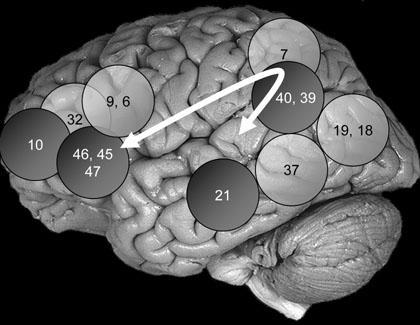
Fig. 1. Source: UC Irvine, CA
What is Intelligence?
Wiki: Intelligence (from Latin intellectus - understanding, cognition) is the mind, reason, and mental ability: to learn from experience, adapt, adapt to new situations, apply knowledge to manage the environment or think abstractly (from Encyclopedia Britannica). The general ability to cognize and solve problems, which combines all the cognitive abilities of an individual: sensation, perception, memory, representation, thinking, imagination (from the Dictionary of methodological terms).
English Wikipedia provides a list of options for determining intelligence by various scientists and groups right away, among which the following are most interesting:
philosophical:
- the general ability of the individual to targeted action, rational thinking and effective interaction with the environment (David Wechsler).
- targeted adaptive behavior (Sternberg & Salter).
applied:
- the result of the processes of collecting, storing, accessing, combining, comparing, and using information and skills in new contexts (Lloyd Humphreys).
abstract:
- the ability to cope with cognitive complexity (Linda Gottfredson).
anthropocentric:
- the unique tendency of human beings to change the structure of their cognitive functions to better adapt to changing conditions of life situations (Reuven Feuerstein).
The American Psychological Association offers the following definition (which, in my opinion, is most often found in articles):
“Individuals differ from each other in their ability to understand complex ideas, adapt effectively to the environment, learn from experience, participate in various forms of reflection, overcome difficulties by thinking ”[1].
It turns out that there is no exact definition, but in order to start measuring something, you need to imagine it in detail, and it’s even more difficult to do something that does not have a clear technical specification. Therefore, the general problem of intelligence is divided into sub-tasks and they are already trying to solve them, or to find the areas of the brain responsible for them. The most common method for studying the functions of any area of the brain is to find a person for whom it does not work (there was a stroke or damage) and see what is missing in its behavior. Then the results of many such studies are collected together and look at what happened.
But it turns out, for example, that general intelligence (general intelligence is such an invented measure, based on the results of testing people) is not concentrated in any one area of the brain, but rather is distributed among different areas and connections between them and “depends on the work of the whole brain ”[2]. This, in turn, leads us to the conclusion that the ability of the brain depends on how much the brain can integrate disparate information [2]. This confirms the theory put forward earlier [3] about the relationship of intelligence with the ability of information to “travel” through different areas of the brain (Fig. 1). Thus, it is not enough to be able to control attention, work with memory and language, it is necessary to tie this whole thing together effectively.
However, it remains unclear whether a strong AI will turn out (strong AI is a concept of AI similar in ability to the human brain) if we take the modules of memory, attention, language, etc., and simply connect them. And how should they be combined so that the very process of integrating information begins.
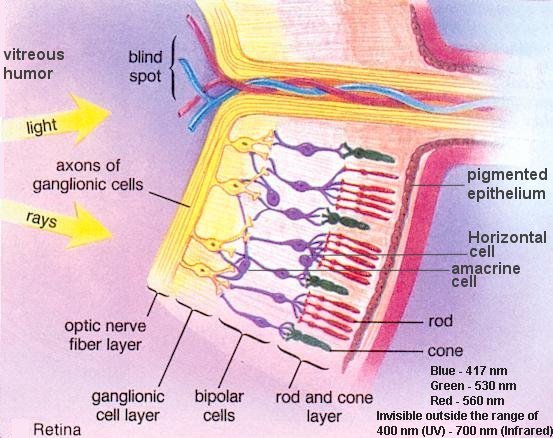
Fig. 2 Source: cidpusa.org
Take, for example, the eye. It has a retina on which the current image is projected. The retina consists of photosensitive cells (about 120 million pieces of tubules / rods and cones) connected to the optic nerve (through several layers of other neurons) in an interesting way (Fig. 2): note, first the light must break through the nerve fibers, and then only register photosensitive cells. The nature of the blind spot follows from such an organization.
But what is transmitted along the optic nerve? And on it action potentials (AR) are already transmitted, and in the form of a series of pulses. Moreover, it was noticed that most cells have light with a “favorite” wavelength, which increases the repetition rate of the AP, while light of a different wavelength reduces the frequency. Accordingly, there are cells that love longer wavelengths, and there are loving shortwave ones [4]. Hence the opportunity to see different colors (and, in fact, the way they are encoded). It is worth noting here that several photosensitive tubes and / or cones from a certain region (receptive field) are broadcasting into one neuron of the optical nerve, and the signals from the center of this region and from its periphery are, as a rule, antagonistic, i.e. if the center excites a neuron, then the periphery drowns out. It turns out that there are, as it were, two informational “channels” in the optical nerve, one of which responds by increasing activity to signals lighter than the background, and the other to signals darker than the background. Such an organization allows us to respond not to the general level of lighting (as in digital cameras), but to a local change in illumination, thereby increasing the dynamic range (which is why we see in HDR and where visual illusions based on lighting originate from).
At this stage, only the spectral characteristics of the incoming image are transmitted, no geometry analysis or pattern recognition.
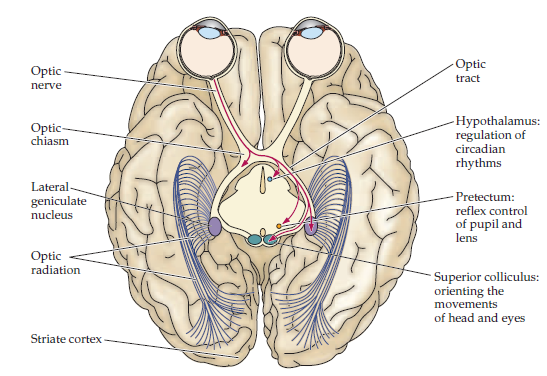
Fig. 3 Optic tract
All this wealth is transmitted through the optic nerve (Fig. 3) through various brain structures right to the back of the head, where the visual cortex is located (from here, by the way, I hit my head - stars sprinkled). Typically, the right half of the field of view from both eyes is transmitted to the left hemisphere, and the left half of the field of view is again from both eyes to the right, which allows processing signals from both eyes in one place in the overlapping region (Fig. 4). But that is not all. Part of the nerves goes into the pretectum, which is responsible for the reflex narrowing of the pupils. But we will not delve into the schematic of ortic signals, in the end we are interested in what the brain itself does with all this, that it turns out intelligence and advanced cognitive activity?

Fig. 4 areas of the optic tract
So, up to the visual cortex (striate or visual cortex), the information goes as it was out of the eye, and now something similar to recognizing the relative position of the signals begins in the cortex. For example, neurons were found that actively respond to the angle of inclination of the presented rectangle (Fig. 5), its length, direction of displacement, and other simple image attributes. Moreover, the organization of such neurons is not random, but very consistent and logical (Fig. 6) and, as it were, makes up a map of alternating layers. As a result, it turns out that the visual cortex consists of repeating modules that can evaluate a specific area of the field of view from a whole set of properties. And such a structure can be found in almost all areas of the cortex (not only visual, but also auditory and sensory). Moreover, There is an additional separation of pathways from lateral geniculate nucleus (LGN) to visual cortex, based on two types of neurons entering the LGN (M ganglion cells and P ganglion cells). These two types of neurons have different sizes of the sensitive region (M cells have longer dendrites) and the speed of information transfer, as a result of which M cells respond more strongly to fast stimuli and P cells to slow ones, plus P cells can transmit color information, and M is not. The significance of these two paths is as follows: damage to M cells leads to a decrease in the ability to respond to rapid changes in the situation without affecting the ability to see in color, while damage to P cells significantly affects the quality of vision, but does not affect the response to fast stimuli. There is a third way - through K cells,

Fig. 5. The response of neurons in the visual cortex depending on the slope of the image.
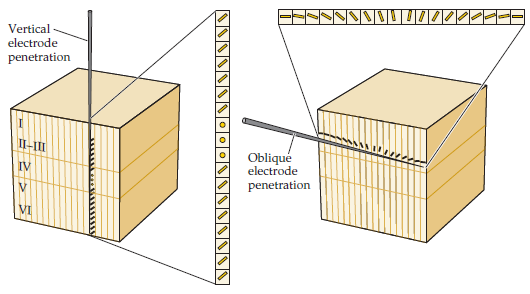
Fig. 6. The spatial organization of neurons in the visual cortex that respond to specific stimuli.
Further, the information enters the following areas of the visual cortex (Fig. 7), where the partial reorganization and integration of the obtained data takes place: for example, in the V4 zone, neurons respond to color regardless of movement or direction, and in the MT zone (middle temporal area) on the contrary, neurons respond exclusively to the direction of movement of the edge of the object, regardless of its color.
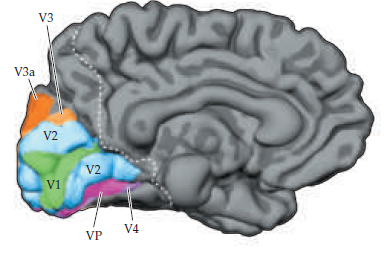
Fig. 7. Zones of the visual cortex.
Damage in such areas leads to specific sensations in patients. For example, damage in the MT zone leads to “motor blindness” - the inability to see movement: the patient described the tea flowing from the kettle as iced. That is, neurons before MT process the whole image completely and the person, generally speaking, sees the entire field of view, but the integration of motor information into the overall picture does not occur and it is lost from conscious perception. An interesting point is that unconsciously such information can still be processed. There are cases when, due to a stroke, in a high-level zone of the visual cortex, a person is actually blind, but at the same time moving around the room he quite successfully walked around objects. This happened because at least the ways to consciously process information were damaged,
In this intricate way, information reaches the brain and is processed by it. And of course there are more questions than answers, but I hope I managed to shed some light on the brain and the principles of information processing and integration.
UPD: forgot links
[1] Intelligence: Knowns and unknowns, Neisser et al., American Psychologist, 1996, 51 (2), 77–101.
[2] Distributed neural system for general intelligence revealed by lesion mapping, Glascher et al., PNAS, 2010, 107: 10, 4705-4709.
[3] The Parieto-Frontal Integration Theory (P-FIT) of intelligence: Converging neuroimaging evidence, Jung et al., Behavioral and Brain Sciences, 2007, 30, 135-187.
[4] Neural mechanisms of color vision, De Valois et al., Comprehensive Physiology, 2011, 425-456.
Start here: Neurobiology and artificial intelligence: part one - educational program ,
and here: Neurobiology and artificial intelligence: part one and a half - news from the Blue Brain Project .
Now, armed with new knowledge, we can speculate on how the transport of ions through membranes leads to intelligence and consciousness. No one can give a correct, complete and clear answer so far, so we will consider the current situation with examples.
I want to remind you that this series of articles does not pretend to be a detailed description of all the processes involved in the cognitive activity of the brain, but is descriptive in order to give interested people an idea of the principles of the brain, intelligence and consciousness.
And how is intelligence related to the activity of neurons?

Fig. 1. Source: UC Irvine, CA
What is Intelligence?
Wiki: Intelligence (from Latin intellectus - understanding, cognition) is the mind, reason, and mental ability: to learn from experience, adapt, adapt to new situations, apply knowledge to manage the environment or think abstractly (from Encyclopedia Britannica). The general ability to cognize and solve problems, which combines all the cognitive abilities of an individual: sensation, perception, memory, representation, thinking, imagination (from the Dictionary of methodological terms).
English Wikipedia provides a list of options for determining intelligence by various scientists and groups right away, among which the following are most interesting:
philosophical:
- the general ability of the individual to targeted action, rational thinking and effective interaction with the environment (David Wechsler).
- targeted adaptive behavior (Sternberg & Salter).
applied:
- the result of the processes of collecting, storing, accessing, combining, comparing, and using information and skills in new contexts (Lloyd Humphreys).
abstract:
- the ability to cope with cognitive complexity (Linda Gottfredson).
anthropocentric:
- the unique tendency of human beings to change the structure of their cognitive functions to better adapt to changing conditions of life situations (Reuven Feuerstein).
The American Psychological Association offers the following definition (which, in my opinion, is most often found in articles):
“Individuals differ from each other in their ability to understand complex ideas, adapt effectively to the environment, learn from experience, participate in various forms of reflection, overcome difficulties by thinking ”[1].
It turns out that there is no exact definition, but in order to start measuring something, you need to imagine it in detail, and it’s even more difficult to do something that does not have a clear technical specification. Therefore, the general problem of intelligence is divided into sub-tasks and they are already trying to solve them, or to find the areas of the brain responsible for them. The most common method for studying the functions of any area of the brain is to find a person for whom it does not work (there was a stroke or damage) and see what is missing in its behavior. Then the results of many such studies are collected together and look at what happened.
But it turns out, for example, that general intelligence (general intelligence is such an invented measure, based on the results of testing people) is not concentrated in any one area of the brain, but rather is distributed among different areas and connections between them and “depends on the work of the whole brain ”[2]. This, in turn, leads us to the conclusion that the ability of the brain depends on how much the brain can integrate disparate information [2]. This confirms the theory put forward earlier [3] about the relationship of intelligence with the ability of information to “travel” through different areas of the brain (Fig. 1). Thus, it is not enough to be able to control attention, work with memory and language, it is necessary to tie this whole thing together effectively.
However, it remains unclear whether a strong AI will turn out (strong AI is a concept of AI similar in ability to the human brain) if we take the modules of memory, attention, language, etc., and simply connect them. And how should they be combined so that the very process of integrating information begins.
But what is the information from the point of view of the brain?

Fig. 2 Source: cidpusa.org
Take, for example, the eye. It has a retina on which the current image is projected. The retina consists of photosensitive cells (about 120 million pieces of tubules / rods and cones) connected to the optic nerve (through several layers of other neurons) in an interesting way (Fig. 2): note, first the light must break through the nerve fibers, and then only register photosensitive cells. The nature of the blind spot follows from such an organization.
But what is transmitted along the optic nerve? And on it action potentials (AR) are already transmitted, and in the form of a series of pulses. Moreover, it was noticed that most cells have light with a “favorite” wavelength, which increases the repetition rate of the AP, while light of a different wavelength reduces the frequency. Accordingly, there are cells that love longer wavelengths, and there are loving shortwave ones [4]. Hence the opportunity to see different colors (and, in fact, the way they are encoded). It is worth noting here that several photosensitive tubes and / or cones from a certain region (receptive field) are broadcasting into one neuron of the optical nerve, and the signals from the center of this region and from its periphery are, as a rule, antagonistic, i.e. if the center excites a neuron, then the periphery drowns out. It turns out that there are, as it were, two informational “channels” in the optical nerve, one of which responds by increasing activity to signals lighter than the background, and the other to signals darker than the background. Such an organization allows us to respond not to the general level of lighting (as in digital cameras), but to a local change in illumination, thereby increasing the dynamic range (which is why we see in HDR and where visual illusions based on lighting originate from).
At this stage, only the spectral characteristics of the incoming image are transmitted, no geometry analysis or pattern recognition.

Fig. 3 Optic tract
All this wealth is transmitted through the optic nerve (Fig. 3) through various brain structures right to the back of the head, where the visual cortex is located (from here, by the way, I hit my head - stars sprinkled). Typically, the right half of the field of view from both eyes is transmitted to the left hemisphere, and the left half of the field of view is again from both eyes to the right, which allows processing signals from both eyes in one place in the overlapping region (Fig. 4). But that is not all. Part of the nerves goes into the pretectum, which is responsible for the reflex narrowing of the pupils. But we will not delve into the schematic of ortic signals, in the end we are interested in what the brain itself does with all this, that it turns out intelligence and advanced cognitive activity?

Fig. 4 areas of the optic tract
So, up to the visual cortex (striate or visual cortex), the information goes as it was out of the eye, and now something similar to recognizing the relative position of the signals begins in the cortex. For example, neurons were found that actively respond to the angle of inclination of the presented rectangle (Fig. 5), its length, direction of displacement, and other simple image attributes. Moreover, the organization of such neurons is not random, but very consistent and logical (Fig. 6) and, as it were, makes up a map of alternating layers. As a result, it turns out that the visual cortex consists of repeating modules that can evaluate a specific area of the field of view from a whole set of properties. And such a structure can be found in almost all areas of the cortex (not only visual, but also auditory and sensory). Moreover, There is an additional separation of pathways from lateral geniculate nucleus (LGN) to visual cortex, based on two types of neurons entering the LGN (M ganglion cells and P ganglion cells). These two types of neurons have different sizes of the sensitive region (M cells have longer dendrites) and the speed of information transfer, as a result of which M cells respond more strongly to fast stimuli and P cells to slow ones, plus P cells can transmit color information, and M is not. The significance of these two paths is as follows: damage to M cells leads to a decrease in the ability to respond to rapid changes in the situation without affecting the ability to see in color, while damage to P cells significantly affects the quality of vision, but does not affect the response to fast stimuli. There is a third way - through K cells,

Fig. 5. The response of neurons in the visual cortex depending on the slope of the image.

Fig. 6. The spatial organization of neurons in the visual cortex that respond to specific stimuli.
Further, the information enters the following areas of the visual cortex (Fig. 7), where the partial reorganization and integration of the obtained data takes place: for example, in the V4 zone, neurons respond to color regardless of movement or direction, and in the MT zone (middle temporal area) on the contrary, neurons respond exclusively to the direction of movement of the edge of the object, regardless of its color.

Fig. 7. Zones of the visual cortex.
Damage in such areas leads to specific sensations in patients. For example, damage in the MT zone leads to “motor blindness” - the inability to see movement: the patient described the tea flowing from the kettle as iced. That is, neurons before MT process the whole image completely and the person, generally speaking, sees the entire field of view, but the integration of motor information into the overall picture does not occur and it is lost from conscious perception. An interesting point is that unconsciously such information can still be processed. There are cases when, due to a stroke, in a high-level zone of the visual cortex, a person is actually blind, but at the same time moving around the room he quite successfully walked around objects. This happened because at least the ways to consciously process information were damaged,
In this intricate way, information reaches the brain and is processed by it. And of course there are more questions than answers, but I hope I managed to shed some light on the brain and the principles of information processing and integration.
UPD: forgot links
[1] Intelligence: Knowns and unknowns, Neisser et al., American Psychologist, 1996, 51 (2), 77–101.
[2] Distributed neural system for general intelligence revealed by lesion mapping, Glascher et al., PNAS, 2010, 107: 10, 4705-4709.
[3] The Parieto-Frontal Integration Theory (P-FIT) of intelligence: Converging neuroimaging evidence, Jung et al., Behavioral and Brain Sciences, 2007, 30, 135-187.
[4] Neural mechanisms of color vision, De Valois et al., Comprehensive Physiology, 2011, 425-456.
